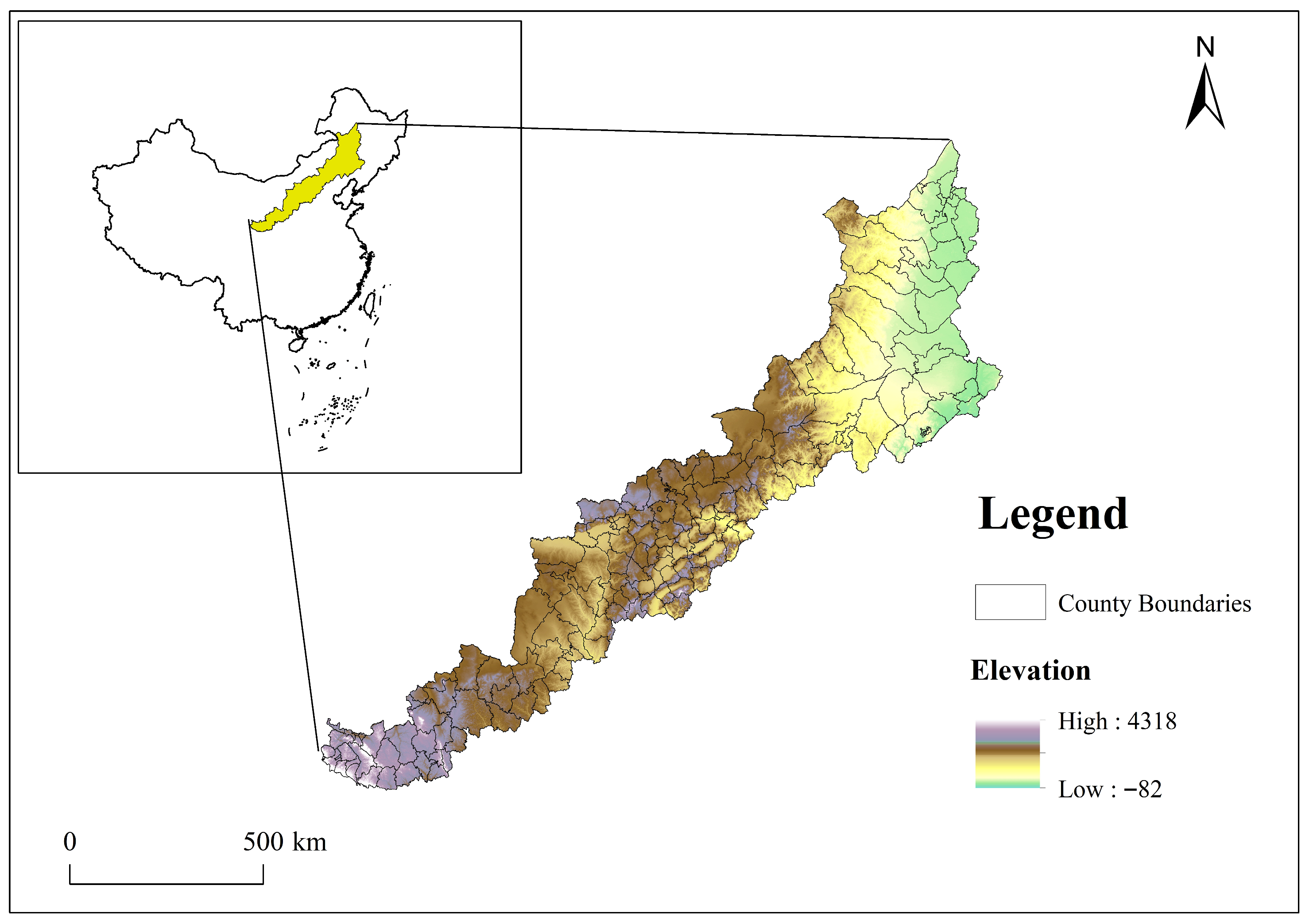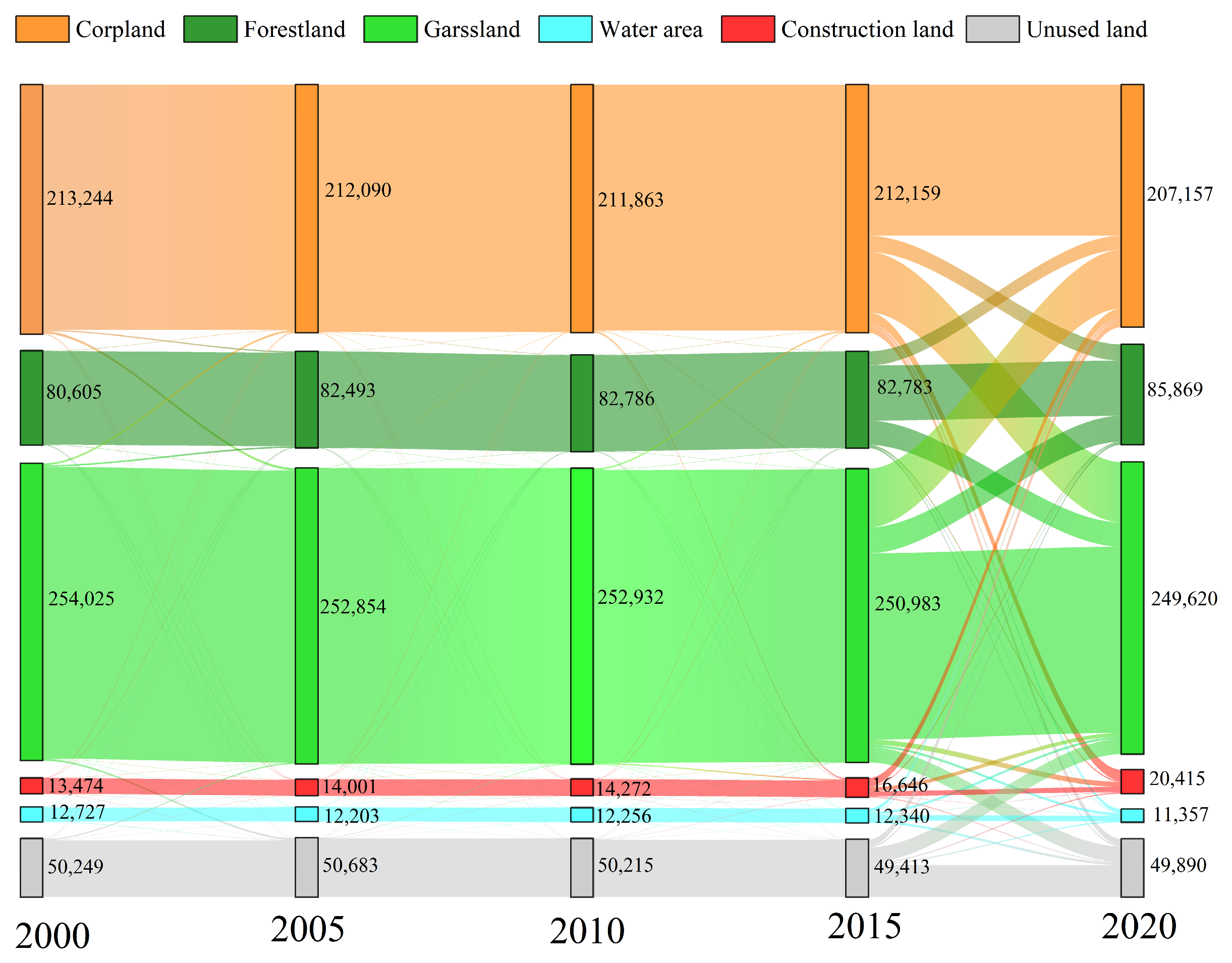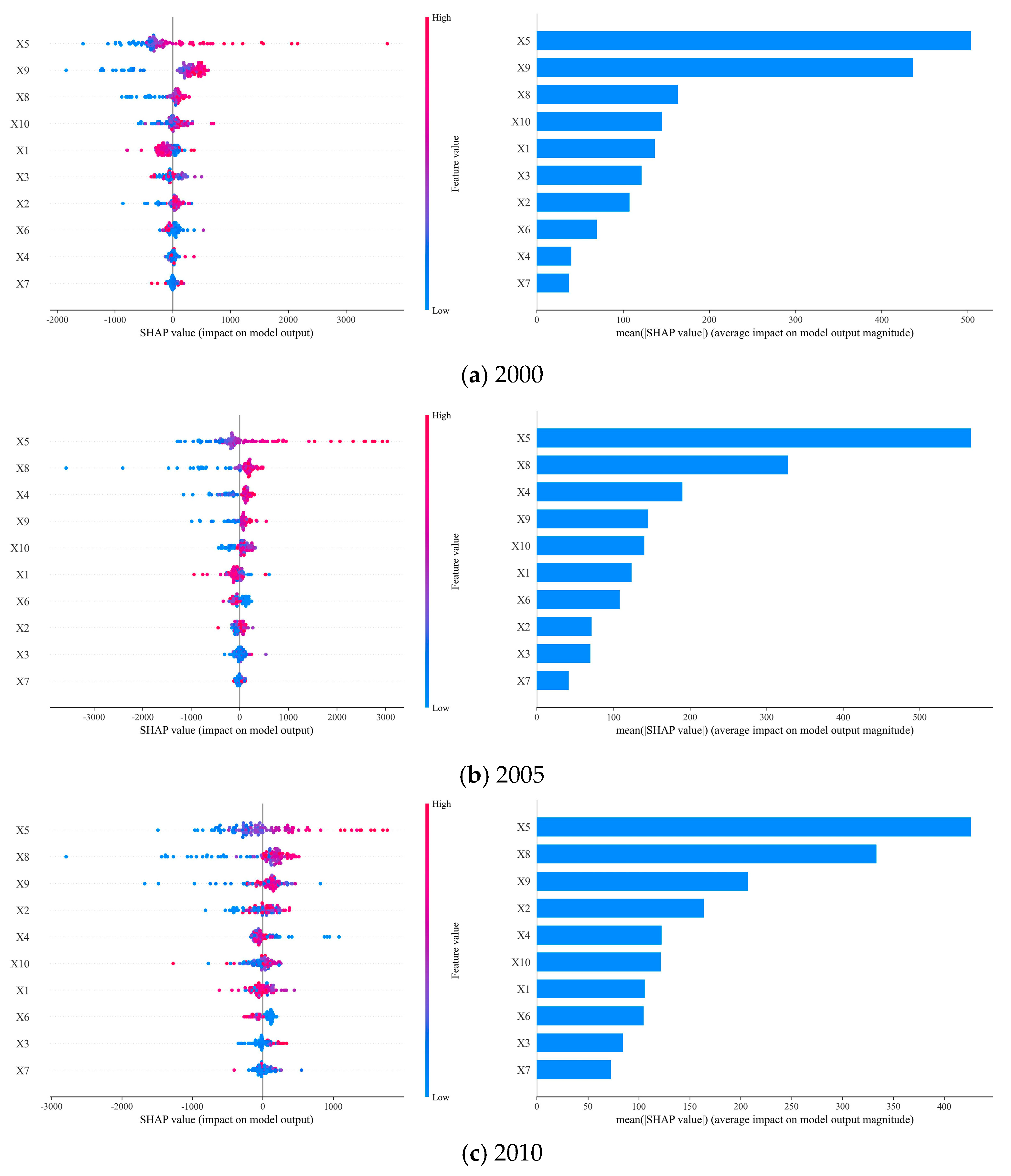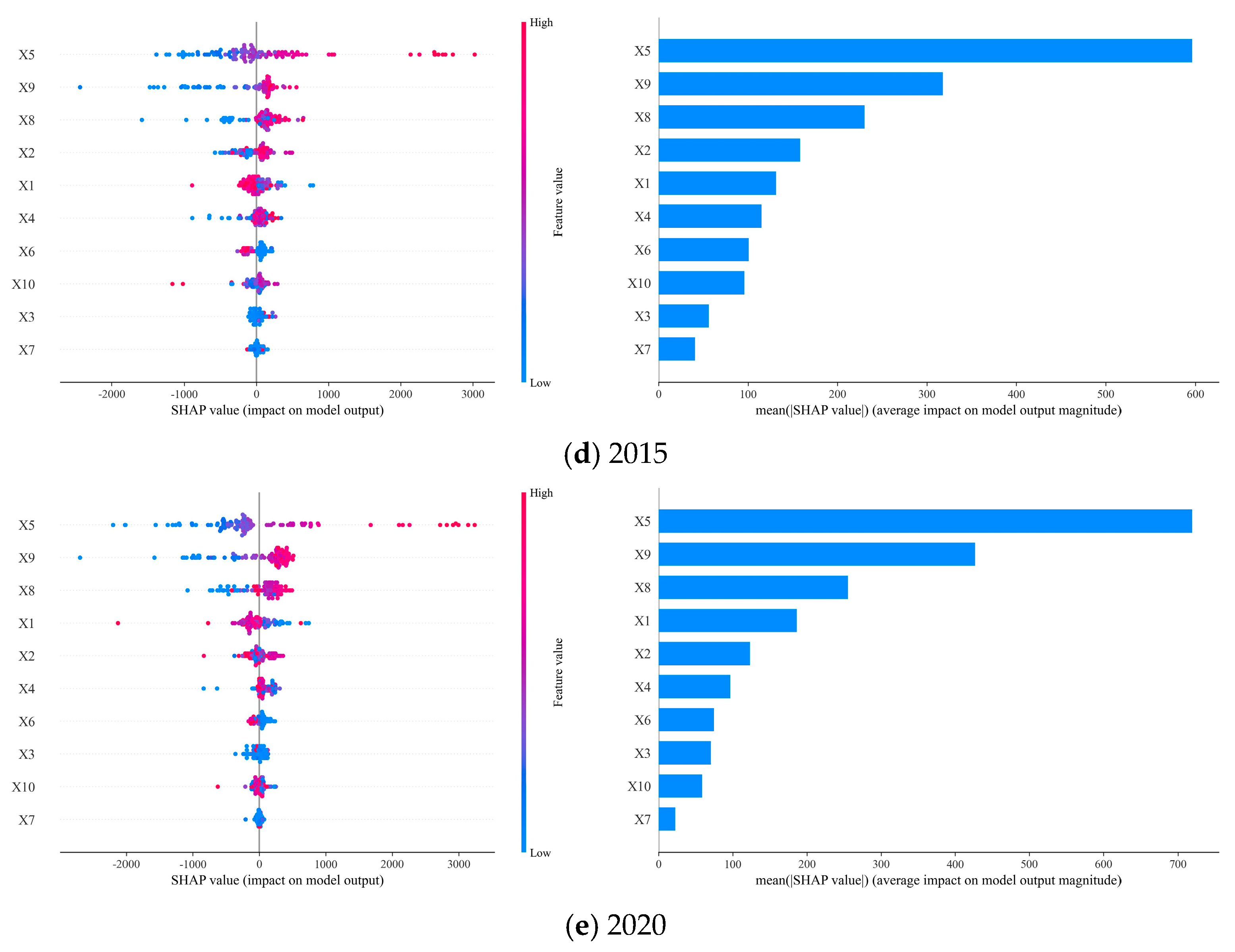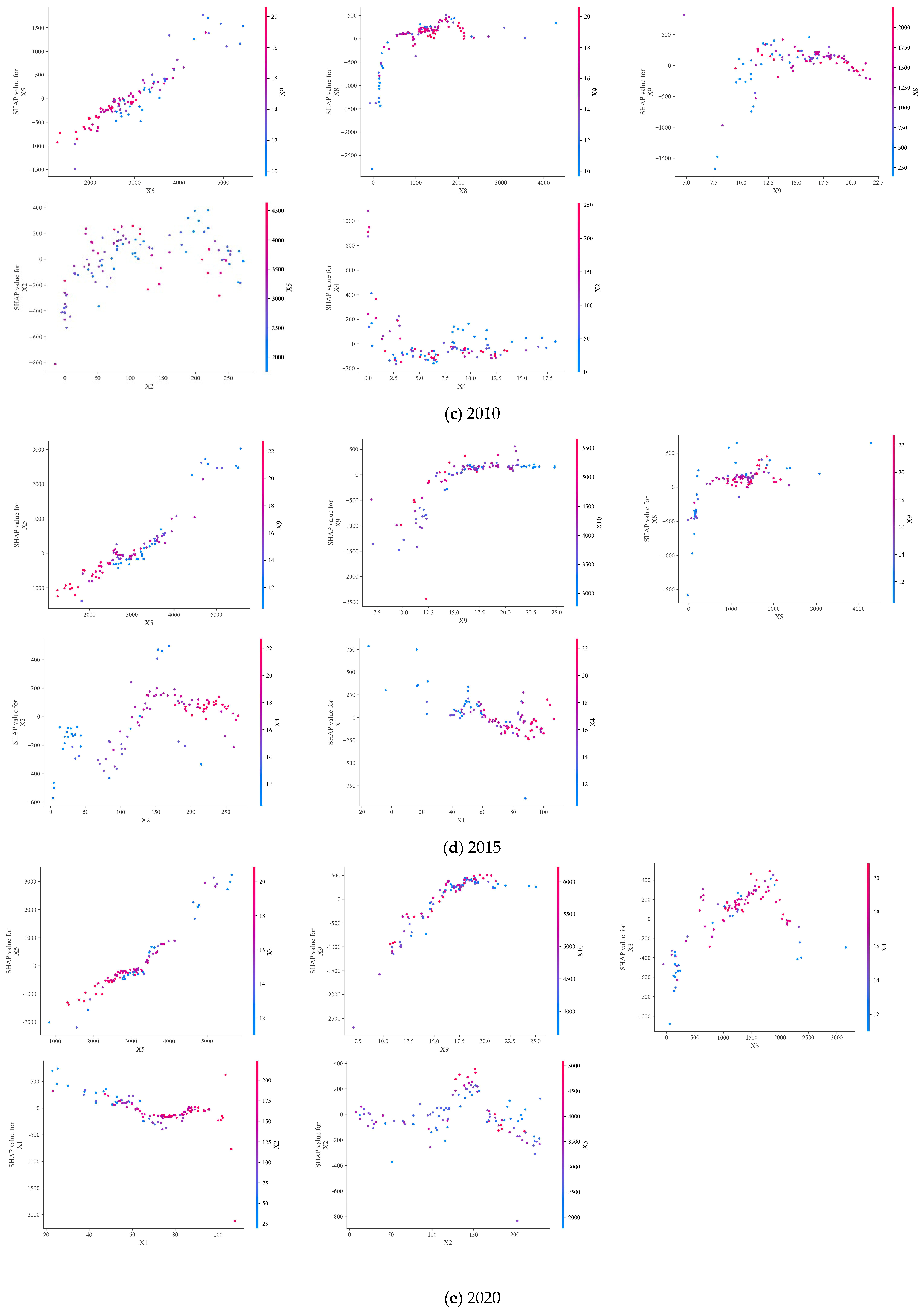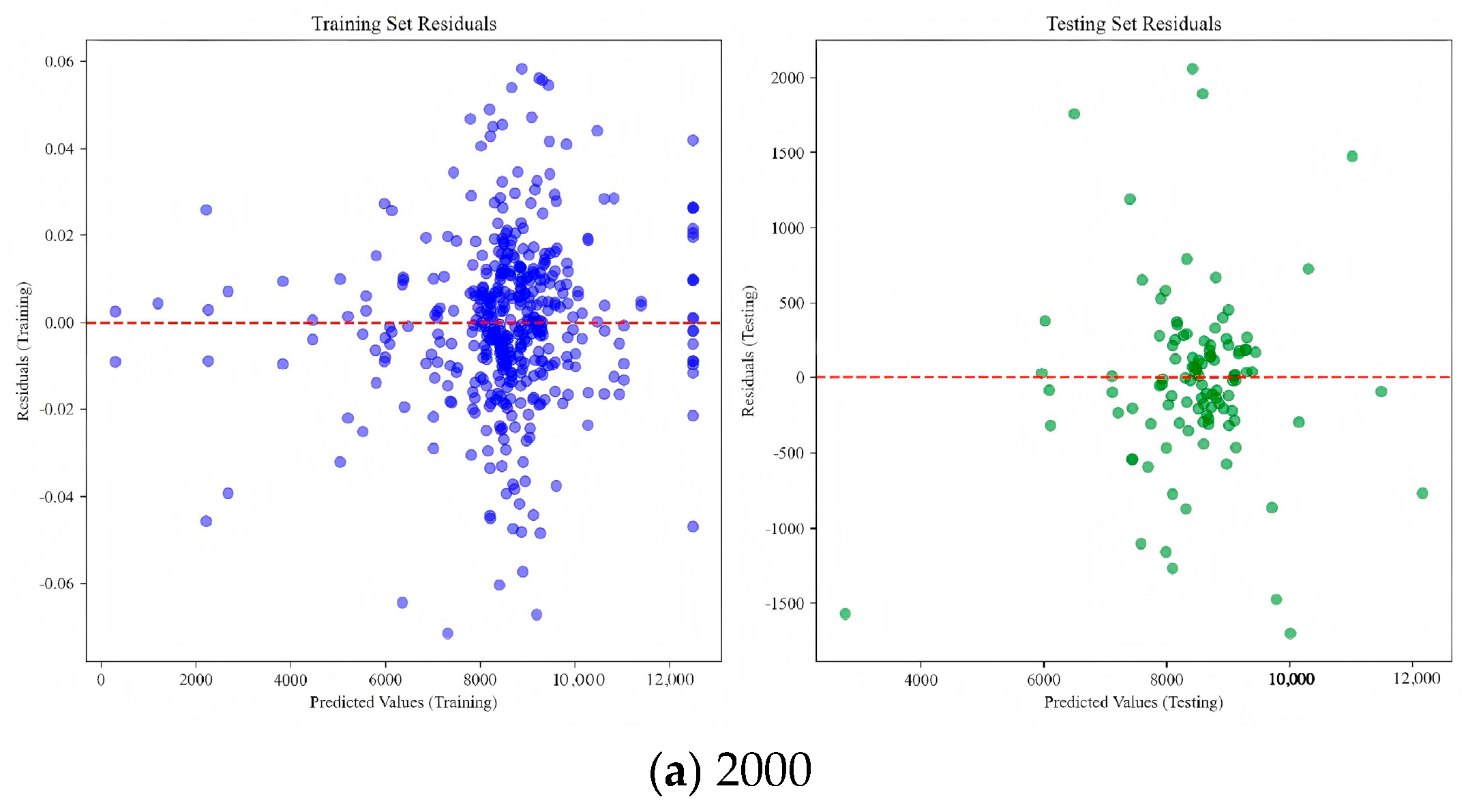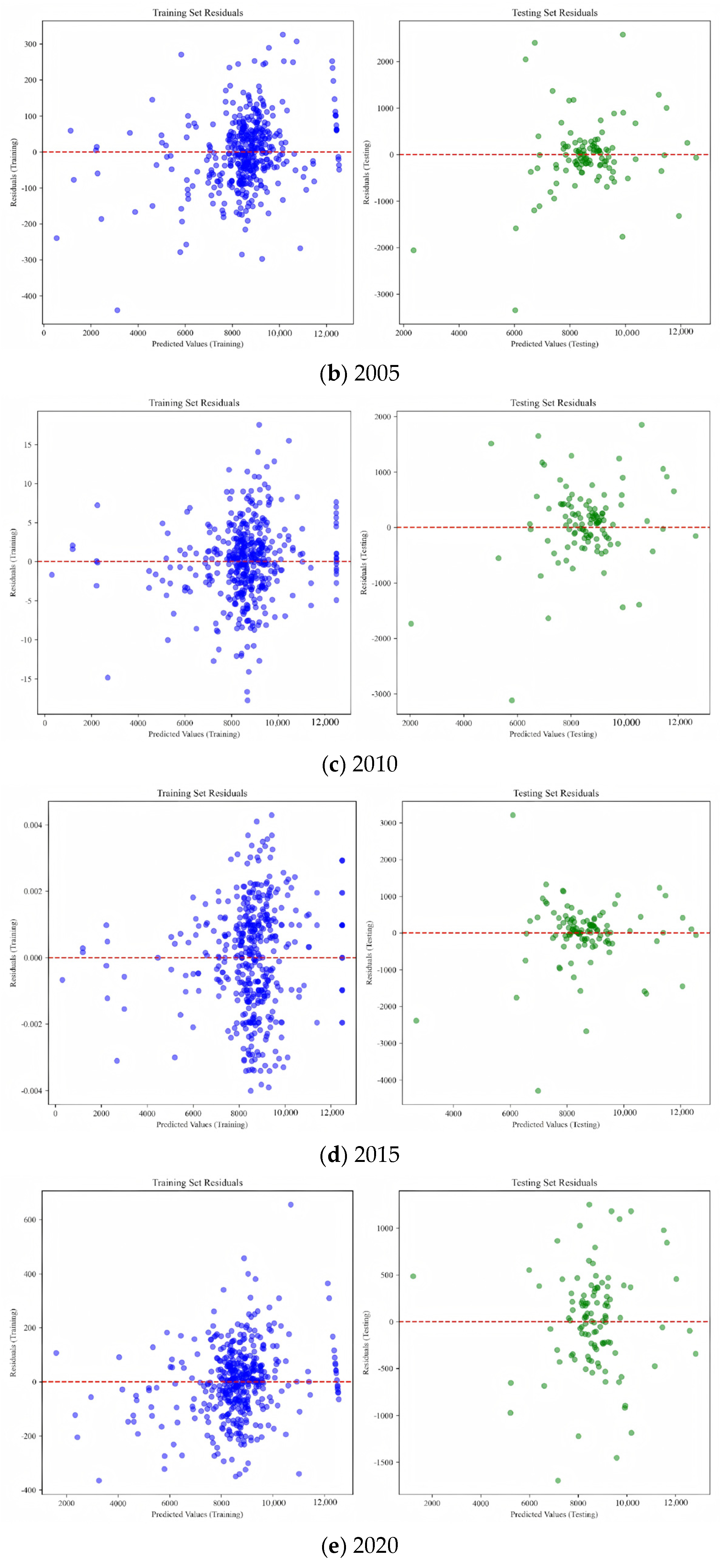1. Introduction
In recent years, global climate change has led to frequent extreme weather events, exerting profound impacts on global ecosystems and human society [
1]. As a core strategy to address climate change, carbon neutrality has become a global consensus and a key action pathway [
2,
3]. As an important component of the global carbon cycle, terrestrial ecosystem carbon storage not only occupies a central position in climate regulation [
4], but its dynamic changes also directly affect the balance of regional carbon budgets. The global terrestrial ecosystem can absorb approximately 25% of anthropogenic carbon dioxide emissions annually, forming a crucial terrestrial carbon sink [
5]. Enhancing the carbon sequestration capacity of ecosystems is therefore regarded as a sustainable strategy to mitigate climate change [
6]. Among the driving factors, Land Use and Cover Change (LUCC) is a core factor shaping terrestrial carbon cycle processes [
7]. It refers to the long-term dynamic changes in surface land use types (such as cropland, forestland, construction land, water area and unused land) and their cover conditions driven by human activities or natural processes, and is crucial because it directly affects the direction and intensity of carbon cycling by altering vegetation and soil carbon pools. By altering surface vegetation types and soil carbon pool structures, LUCC acts as a key variable triggering changes in regional carbon storage. Activities such as urban expansion and deforestation have significantly weakened the carbon sequestration capacity of ecosystems [
8,
9]. With the intensification of global warming and the acceleration of urbanization, land use patterns are transforming at an unprecedented rate [
10], severely disrupting the carbon cycle and increasing the risk of carbon imbalance. Therefore, in-depth exploration of the dynamic characteristics of LUCC and its mechanism of action on carbon storage is of vital significance for promoting the implementation of regional sustainable development strategies and facilitating the achievement of carbon neutrality goals.
In the LUCC implementation strategy report jointly released by the International Geosphere-Biosphere Programme (IGBP) and the International Human Dimensions Programme on Global Environmental Change (IHDP), it is emphasized that, due to significant regional differences in the impacts and responses of LUCC to global change, regional-scale LUCC research should focus on “key areas”, “hotspot areas”, and “vulnerable areas” [
11]. In China, LUCC research in vulnerable ecological regions has mainly concentrated on the Loess Plateau, oases, arid regions, river deltas, and agri-forestry/agro-pastoral ecotones [
12]. The northern agro-pastoral ecotone serves as China’s second ecological security barrier following the natural grasslands in pastoral areas; it also functions as an ecological barrier for central and eastern China and an important water conservation area for the Beijing–Tianjin–Hebei region [
13]. Characterized by an overall fragile ecological background, the region exhibits rapid responses to external disturbances, high sensitivity, and large variability, making it a typical area where ecological vulnerability, environmental sensitivity, and high agricultural economic risks coexist. This region is undergoing drastic LUCC transitions driven by the Grain for Green Program [
14,
15]; coupled with semi-arid climatic fluctuations, these transitions result in highly nonlinear dynamics of carbon storage [
16,
17,
18].
A variety of methods are available for assessing terrestrial ecosystem carbon storage, including sample surveys, remote sensing estimation, and model simulation. These traditional methods are often time-consuming and labor-intensive and are not suitable for large-scale regional studies. In recent years, carbon storage estimation methods have become more complex and diverse. The Integrated Valuation of Ecosystem Services and Trade-offs (InVEST) model has emerged as a widely used tool owing to its ease of operation, flexible parameters, and relatively accurate results [
19,
20]. Studies have applied the PLUS-InVEST model to estimate green and blue carbon stocks in Zhangzhou City, Fujian Province (2000–2020), and predict future trends, highlighting land use as a key driver of carbon stock changes and the study’s significance for China’s “dual-carbon” goals [
21]. researchers have utilized the MCCA-InVEST model to simulate carbon storage changes in Chengdu (2025–2035) under three scenarios (natural development, ecological conservation, sustainable development), clarifying the critical role of land use patterns in balancing ecological security and economic growth [
22]. Scholars have also employed the PLUS-InVEST model to predict carbon storage trends in the Dongting Lake Basin (2030–2060), with results showing that the ecological conservation scenario effectively curbs regional carbon loss [
23]. Existing studies have assessed the spatiotemporal changes in regional ecosystem carbon storage at different scales, such as river basins [
24,
25], administrative divisions [
26,
27], and national parks [
28,
29]. Gaining a deep understanding of the driving mechanisms behind carbon storage changes and analyzing the contribution of various influencing factors are crucial for the precise regulation of ecosystem carbon sequestration functions. Geodetector is widely used in driving factor analysis because it can measure geographical differences and interactions between different driving factors [
30,
31]. Studies have found that forest expansion driven by ecological restoration projects can significantly increase carbon storage, while the reduction in cropland and rangeland areas caused by urbanization leads to obvious carbon loss [
32]; other research has pointed out that accelerated urbanization in the Panxi region of Sichuan Province has resulted in a decrease in cropland and grassland areas, ultimately leading to a decline in regional carbon storage [
33]. These studies have confirmed the universal impact of LULC on carbon storage, but in-depth and systematic research on the unique “land use conflict–carbon sink response” mechanism in agro-pastoral ecotones is still lacking. For driving factor analysis, most studies have adopted models such as Geodetector and Optimal Parameters-based Geographical Detector (OPGD) to clarify the impact of driving factors on the spatial distribution of carbon storage [
33,
34]. Scholars have used the OPGD model to analyze the driving factors of carbon storage in the coastal region of central Vietnam [
34], while others have applied the Geodetector model to explore the driving mechanism of carbon storage in the Panxi region [
33]. Geographically Weighted Regression (GWR) and Structural Equation Modeling (SEM) have been used to examine the interactions of climate, land use, and socioeconomic variables on carbon storage dynamics [
35,
36]. Machine learning models and the SHAP (SHapley Additive exPlanations) method have also been extensively applied in such studies. Against this backdrop, machine learning methods, with their advantage in handling complex nonlinear relationships, are increasingly used to identify factors influencing the carbon cycle [
37,
38]. In particular, the XGBoost (Extreme Gradient Boosting) model, renowned for its efficiency and flexibility, can uncover potential patterns that are difficult to capture using traditional methods [
39]. However, due to the complexity of their internal decision-making processes, machine learning models are often regarded as “black boxes”, which makes their interpretations less intuitive. Moreover, machine learning models alone cannot clarify the spatial differentiation of carbon sinks or the specific mechanisms of their driving factors. The SHAP method, derived from game theory (Shapley value), can effectively address this limitation [
40]; it provides a transparent and interpretable framework that not only improves the predictive ability of the model but also enhances the understanding of factors influencing carbon sinks.
Current studies on carbon storage mostly focus on relatively stable ecosystems, while exploration of the “land use conflict–carbon sink response” feedback mechanism in ecotonal zones remains insufficient, failing to reflect the nonlinear carbon dynamics of ecologically fragile regions; furthermore, although machine learning models have been applied to analyze the driving factors of carbon storage, few studies integrate interpretable frameworks to quantify the spatial heterogeneity of factor contributions and their interannual evolutionary mechanisms, thereby restricting the precision of carbon sink regulation strategies—this study aims to address three interconnected questions, namely: how the spatiotemporal patterns of carbon storage in China’s northern agro-pastoral ecotone have evolved from 2000 to 2020 and what differences exist in carbon dynamic characteristics across different land use types; which factors dominate the spatial heterogeneity of carbon storage in this region and how their driving mechanisms have changed; and what the coupling mechanism is between LUCC processes and carbon sink function responses in this ecologically fragile zone, as well as how to enhance regional carbon sequestration capacity through land use optimization.
Based on the above context, this study selects China’s northern agro-pastoral ecotone as the research area. As a typical ecologically vulnerable region and an area with active land use transitions, this region’s drastic LUCC processes and complex carbon sink response mechanisms urgently require in-depth analysis. This study integrates the InVEST model, XGBoost machine learning algorithm, and SHAP interpretation framework to construct a comprehensive research scheme for assessment and attribution analysis. First, the InVEST model is used to quantify the spatiotemporal dynamics of carbon storage under long-term land use changes in the region; second, the XGBoost model is employed to deeply explore and model the complex nonlinear relationships between carbon storage changes and multi-dimensional driving factors; finally, the SHAP value interpretation framework is utilized to quantify the contribution of each driving factor to the spatial heterogeneity of carbon sinks and its mechanism of action. The aim is to reveal the coupling mechanism of “land use transition–carbon sink function response” in this critical ecological ecotone, thereby providing scientific support for the optimal management of regional land use and the design of carbon neutrality pathways.
2. Materials and Methods
2.1. Overview of the Study Area
The northern agro-pastoral ecotone is a transitional and ecologically fragile area between the agricultural regions in northern China and the pastoral regions. It is located at the southeastern edge of the Inner Mongolia Plateau and the northern part of the Loess Plateau, covering 154 counties (banners or cities) across 9 provinces (Autonomous Regions) in China, including Inner Mongolia, Heilongjiang, Jilin, Liaoning, Hebei, Shanxi, Shaanxi, Gansu, and Ningxia. It spans more than 10 degrees of latitude from north to south and over 20 degrees of longitude from east to west (
Figure 1).
Situated in China’s semi-arid transitional zone, the northern agro-pastoral ecotone has a typical temperate, semi-arid continental monsoon climate, with an annual average temperature of approximately 8 °C and an average annual precipitation of 300–450 mm. Agricultural and pastoral landscapes are interspersed in this area, and the vegetation transitions from forest–steppe zones in the east to typical steppe zones and desert steppe zones in the west. Geographically, the region serves as a transition zone from the Northeast China Plain, North China Plain, and Loess Plateau to the Inner Mongolia Plateau and Qinghai–Tibet Plateau, with elevation increasing from northeast to southwest.
2.2. Data Sources
This study utilizes data spanning 2000 to 2020, with detailed sources and processing procedures elaborated as follows:
Land use data: Derived from the annual 1000 m resolution land use/cover datasets (2000, 2005, 2010, 2015, 2020) provided by the Resource and Environmental Science Data Center of the Chinese Academy of Sciences (CAS) (
http://www.resdc.cn, accessed on 21 July 2025). These datasets are classified into 6 primary types (cropland, forestland, grassland, water body, construction land, unused land) and 25 secondary types.
Elevation data: Sourced from the 1000 m resolution Shuttle Radar Topography Mission (SRTM) digital elevation model (DEM) (Version 4.1) via the CAS Resource and Environmental Science Data Center. This dataset covers the entire study area and has undergone preprocessing to ensure topographic continuity, providing foundational data for analyzing elevation-driven carbon spatial patterns.
Land surface temperature (LST) data: Obtained from the MOD11A2 product (8-day composite, 1 km resolution) released by NASA’s Land Processes Distributed Active Archive Center (LP DAAC), accessed through the CAS Resource and Environmental Science Data Center. The dataset includes daytime and nighttime LST in Kelvin, and annual average LST was calculated by averaging valid composites for each year (2000–2020).
Socioeconomic data:
GDP spatial grid data (1 km resolution): Generated by the CAS Resource and Environmental Science Data Center through spatial disaggregation of county-level GDP statistics (from the China Statistical Yearbook) using NPP-VIIRS nighttime light data (to reflect economic activity intensity) and land use data (to weight by built-up area proportion). The dataset was validated against municipal GDP statistics.
Population spatial grid data (1 km resolution): Developed by disaggregating county-level population census data (2000, 2010) and annual estimates (2005, 2015, 2020) from the China Population and Employment Statistical Yearbook, using residential land distribution (from land use data) as a proxy. Sourced from the same CAS database.
Meteorological data: Includes annual average air temperature, precipitation, and potential evapotranspiration (2000–2020) at 1 km resolution, downloaded from the National Tibetan Plateau Scientific Data Center (
http://data.tpdc.ac.cn, accessed on 21 July 2025). These data were spatially interpolated by the Peng Shouzhang team using the thin-plate spline method, incorporating 756 national meteorological station records (1980–2020) and topographic covariates (elevation, slope, aspect).
NDVI data: From NASA’s MODIS NDVI product (MOD13A3), a 1 km resolution, 16-day composite dataset (2000–2020) downloaded via
https://www.earthdata.nasa.gov, accessed on 21 July 2025. The dataset uses a maximum value composite (MVC) method to reduce atmospheric interference, with values ranging from −2000 to 10,000 (scaled by 0.0001).
Grassland grazing intensity data: Provided by the National Ecological Science Data Center (
https://www.nesdc.org.cn, accessed on 21 July 2025) as 1 km resolution annual grid data (2000–2020), expressed in sheep units per hectare (SU/ha). The dataset integrates county-level livestock statistics (sheep, cattle, goats) from the China Rural Statistical Yearbook with grassland area data (from land use datasets).
Carbon density data:
For grasslands, forests, and croplands: We prioritized the 2010s carbon density dataset of China’s terrestrial ecosystems by Xu et al. [
5], which includes aboveground biomass carbon (AGC), belowground biomass carbon (BGC), and soil organic carbon (SOC, 0–100 cm depth) densities. For the study area, the aboveground, belowground, and soil carbon densities of grasslands and forests, as well as the soil carbon density of croplands, were extracted from this dataset. For other land use types, relevant literature [
40,
41,
42,
43] was referenced, and adjustments were made based on the research results to obtain carbon density data suitable for the study area (
Table 1).
To ensure spatial consistency, all datasets underwent the following processing using ArcGIS 10.8: Resampling to a 1 km resolution using nearest-neighbor interpolation. They were converted to the WGS1984 geographic coordinate system with consistent row/column counts (1981 × 1885) by cropping to the study area boundary. Temporal consistency: For multi-year datasets, they were aligned to 5-year intervals to match the research period, with missing years interpolated using linear regression.
2.3. Methods
This study employs an integrated technical approach of the InVEST model, XGBoost algorithm, and SHAP framework to investigate carbon storage dynamics and driving mechanisms in the northern agro-pastoral ecotone. To accurately characterize long-term (2000–2020) and large-scale carbon storage spatiotemporal dynamics, the InVEST model integrates four carbon pools and links land use data for quantitative simulation, providing high-precision baseline data. Given the strong nonlinearity in carbon storage dynamics (driven by overlapping LUCC transitions and semi-arid climate fluctuations), the XGBoost algorithm uncovers complex multi-factor coupling relationships inaccessible to traditional linear models. To address the XGBoost “black box” limitation, the SHAP framework quantifies driver contributions, visualizes impacts and interactions, ensuring rigorous mechanism analysis.
Together, they form a complete technical chain of “storage quantification–modeling–mechanism interpretation,” aligning with core research content and objectives.
2.3.1. InVEST Model
The Carbon Storage and Sequestration module in the InVEST model is a key tool for calculating the total carbon storage of terrestrial ecosystems. Based on the compositional characteristics of ecosystem carbon storage, this module divides the carbon storage of each land use type into four basic carbon pools: the aboveground biomass carbon pool (carbon in living plants), belowground biomass carbon pool (carbon in plant roots), soil carbon pool (organic carbon in soil), and dead organic matter carbon pool (carbon in litter and dead plants). In this study, this model was used to calculate the carbon storage of the study area, with the formula as follows:
In the formula, represents the total carbon storage; represents the area of land use type ; , , , and represent the carbon densities in aboveground biomass, belowground biomass, soil, and dead organic matter for each land use type, respectively.
2.3.2. XGBoost Model
XGBoost (Extreme Gradient Boosting) is an ensemble learning decision tree model based on the boosting framework, proposed by Chen and Guestrin in 2016 [
39]. As an efficient implementation of Gradient Boosting Decision Trees (GBDTs), XGBoost exhibits significant differences from traditional GBDT approaches. Compared with conventional gradient boosting tree methods, it demonstrates a notable enhancement in both performance and accuracy. By incorporating a regularization term into the loss function, XGBoost effectively controls model complexity, while its use of the second-order Taylor expansion of the loss function for function approximation significantly improves the model’s fitting accuracy and generalization ability. The XGBoost model is expressed as
The formula refers to the Classification and Regression Tree (CART), where represents the mapping of samples to the leaf nodes of the tree structure, denotes the number of leaf nodes, and stands for the weight corresponding to the leaf node index.
The objective function of the XGBoost model consists of a loss function and a complexity function, and its mathematical expression is
where
is the loss function and
is the complexity function.
Here,
is the L1 regularization term, which serves to control the sparsity of the model;
is the L2 regularization term, which functions to smooth the model parameters. On this basis, the prediction function of the
-th tree is added iteratively, and the second-order Taylor expansion is employed to approximate the objective function, as follows:
2.3.3. SHAP
SHAP provides a technical method for explaining model outputs. SHAP values are derived from the Shapley value in game theory and are constructed as an interpretive model inspired by game theory. This model helps researchers understand the impact and directionality of each feature on specific outcomes and the model as a whole. Therefore, this study employs the TreeSHAP method to explain the predictions made by the XGBoost model on its training dataset. Its calculation formula is as follows:
where
is the Shapley value of the
-th feature;
represents the set of all features;
represents a subset that does not contain the
-th feature;
represents the model output when the
-th feature is included;
is the model output when the
-th feature is not included.
2.3.4. Model Performance Evaluation Metrics
To quantitatively assess the accuracy of the model predictions, three statistical metrics were used: coefficient of determination (R
2), root mean square error (RMSE), and mean absolute error (MAE). R
2 reflects the goodness of fit between the predicted values and the observed values, ranging from 0 to 1. MAE represents the average of the absolute differences between predicted and observed values, reflecting the average prediction deviation. A smaller MAE indicates better model performance. RMSE measures the average magnitude of the prediction errors, with units consistent with the target variable. A smaller RMSE indicates higher prediction accuracy. Their definitions and calculation formulas are as follows:
4. Discussion
4.1. XGBoost Model Accuracy Evaluation
The XGBoost model exhibits an excellent fitting performance and computational efficiency in handling complex, multi-factor nonlinear relationships. However, its inherent black-box nature limits the interpretability of the internal logic of model outputs, which greatly limits the in-depth exploration of the driving mechanisms of carbon sinks. To address this issue, this study adopted the XGBoost–SHAP model to analyze the driving factors influencing carbon storage in the northern agro-pastoral ecotone.
The results show that the model performed well on both the training and test sets (the split ratio of the training set to the test set is 8:2). SHAP values effectively quantified the relative importance of various influencing factors. Results from 10-fold cross-validation confirmed the high reliability of the model (
Table 6). In all experimental years (2000, 2005, 2010, 2015, and 2020), the coefficient of determination (R
2) for the training set was close to 1.00, indicating excellent goodness of fit for the training data. Meanwhile, the training residuals were randomly distributed within a narrow range close to zero, with no systematic biases observed (
Figure 7).
For the test set, the predicted values and the actual values showed a significant linear correlation, with R2 values ranging from 0.73 to 0.88, which proves that the model has good generalization to unseen data. Although the residuals in the test set showed a wider range than those in the training set, they were still randomly distributed around zero, with no systematic bias relative to changes in predicted values being observed. This result not only aligns with a common phenomenon in machine learning, where the error of the test set is usually slightly higher than that of the training set, but also indicates that the model did not suffer from severe overfitting.
4.2. Changes in Carbon Storage
From 2000 to 2020, carbon storage in the agro-pastoral ecotones showed an overall increasing trend, consistent with the conclusions of some scholars. Tong Rongxin et al. [
44] calculated the soil carbon storage of various provinces in China from 2000 to 2020 and showed that provinces with large areas in northern China exhibited a significant increasing trend in soil carbon storage. Similarly, Huang Yan et al. [
45] reported that ecosystem carbon storage in North China also increased during the same period. The present study shows that the carbon storage increased from 5278.10 × 10
6 tons in 2000 to 5308.21 × 10
6 tons in 2020, closely aligning with the research results of Liu Mengzhu et al. [
43]. However, it should be noted that this study reveals a “carbon storage structural contradiction”. Specifically, forest carbon sinks increase by 65.74 × 10
6 tons, while croplands and grasslands suffer a total carbon loss of 89.67 × 10
6 tons. The latter offsets 1.4 times the carbon gain from forests. The reason for this contradiction is as follows: Studies by Liu et al. [
43] only focused on the positive impact of the “Grain for Green Program” on carbon storage. They failed to quantify the negative effects of “two-way conversion between croplands and grasslands” and “construction land occupying high-carbon-density land” in the agro-pastoral ecotone. The unique pattern of “low-intensity total growth combined with high-intensity structural contradiction” in this region differs from the reported conclusion that “soil carbon storage in northern Chinese provinces shows unidirectional growth” [
44]. This difference highlights the unique ecological background of the agro-pastoral ecotone, namely its “intense land use conflicts”. It should be noted that, in the model configuration adopted in this study, the soil carbon density has no interannual changes; therefore, the dynamic changes in carbon storage were mainly driven by the mutual conversion of different land use types in the region. As a highly sensitive human–land transition zone, agro-pastoral ecotones are jointly affected by human activities and ecological policies. On the one hand, population growth and economic development have promoted the reclamation of some wastelands; on the other hand, the long-term implementation of ecological policies, such as the Grain for Green Program, has significantly improved regional vegetation coverage. Taken together, these have reshaped the land use structure and spatial distribution pattern of carbon storage.
From the perspective of land-type contributions, croplands, forests, and grasslands have consistently acted as the core carriers of regional carbon storage throughout the study period, accounting for over 93% of the total. Among them, the expansion of forestland and construction land is the main driver of the increase in carbon storage. In particular, the continuous advancement of the Grain for Green Program has converted croplands with a low-carbon-sequestration capacity into forests with a high-carbon-sequestration capacity, making this land use transition a key pathway for enhancing regional carbon sink function. Similar studies have confirmed that the implementation of large-scale ecological projects, such as the Three-North Shelterbelt Program and the Grain for Green Program, have exerted positive and sustained effects on the improvement of regional carbon storage by changing land cover types [
46,
47,
48,
49]. The results of this study are consistent with these conclusions, further highlighting the important regulatory role of ecological policies in the process of regional carbon sequestration enhancement.
From the perspective of carbon storage components, the soil carbon pool has always been the core carrier of carbon storage in the agro-pastoral ecotones, far exceeding aboveground biomass, belowground biomass, and dead organic matter. In 2000, soil carbon storage in the study area was 4087.25 × 10
6 tons, accounting for 77.4% of the total carbon storage (5278.09 × 10
6 tons) in that year; by 2020, it had increased to 4115.99 × 10
6 tons, accounting for 77.5% of the total carbon storage (5308.21 × 10
6 tons). This proportion remained basically stable over a 20-year period, staying above 77%, highlighting the dominant position of the soil carbon pool in regional carbon storage. This conclusion is consistent with the finding of Deng et al. [
47] on the Loess Plateau, which holds that “soil carbon pools dominate carbon storage”. However, this study further reveals that the growth of soil carbon pools in the agro-pastoral ecotone (28.74 × 10
6 tons) mainly comes from litter input driven by forest expansion. As shown in
Table 4, the conversion of “grassland to forest” contributes 98.97 × 10
6 tons to carbon storage. In contrast, the growth of soil carbon on the Loess Plateau depends more on vegetation root accumulation after croplands are returned to forests/grasslands (under the Grain for Green Program). This difference provides empirical evidence for the differentiation of soil carbon sink enhancement paths in different ecologically fragile areas. This is closely related to the ecological background and land use types of the agro-pastoral ecotones, primarily dominated by cropland, grassland, and forestland. Croplands, long affected by agricultural activities, receive annual inputs of crop residues into the soil; though tillage accelerates organic carbon decomposition, they still maintain a high soil carbon baseline. Grasslands, characterized by dense root systems and continuous litter input, continuously accumulate soil organic carbon, especially the deep roots of perennial herbs, which can stably store carbon in the deep soil and reduce the decomposition risk. Forests gradually supplement the soil carbon pool through litter layer decomposition and root exudate input, while the relatively stable microenvironment under forest canopies (e.g., lower temperature and higher humidity) slows organic matter decomposition, thus improving the soil carbon storage efficiency. In contrast, other carbon pools, such as the aboveground biomass (406.70 × 10
6 tons in 2020), belowground biomass (757.82 × 10
6 tons in 2020), and dead organic matter (27.69 × 10
6 tons in 2020), showed slight growth under the influence of factors such as forest expansion, but their total amounts were always far lower than that of the soil carbon pool.
4.3. Carbon Storage Influencing Factors
In terms of natural factors, the Normalized Difference Vegetation Index (NDVI) is the most critical determinant influencing the distribution of carbon storage, which is consistent with previous research findings [
50,
51,
52]. This is consistent with the conclusion of Wu et al. [
50] that “NDVI dominates carbon storage in Jilin’s ecosystems”. But this study further reveals the “dynamic interaction mechanism” between NDVI and temperature. In 2000, it relied on air temperature; from 2005 to 2015, it shifted to daytime surface temperature; in 2020, it focused on nighttime surface temperature (
Figure 6). This is significantly different from the conclusion of Lai et al. [
37] that “NDVI and precipitation dominate carbon storage” in Hainan Island. The core reason is that under the semi-arid climate of the agro-pastoral ecotone, vegetation growth relies more on the “microenvironment regulated by temperature”. It does not rely on precipitation supply in humid areas. This finding improves the theory of differentiation of carbon storage driving factors in different climate zones. Through photosynthesis, plants absorb carbon dioxide from the atmosphere and convert it into organic matter. Part of this organic matter is stored in plant biomass, while another part enters the soil through root exudates. A higher NDVI usually indicates an increase in vegetation biomass, thereby enhancing the carbon sequestration capacity of ecosystems [
53].
We observed that the interaction effect between NDVI and temperature factors exhibited significant interannual variability, reflecting the complexity of the carbon cycle response to hydrothermal conditions in the agro-pastoral ecotones. In 2000, the interaction between NDVI and air temperature (X1) was the strongest. Then, the land use pattern in the study area was dominated by croplands and medium-to-low-coverage grasslands, where the air temperature directly regulated the crop growth cycle and photosynthetic efficiency of forage grass. Early spring warming advanced the crop sowing period and extended the growing season, while suitable summer temperatures (20–25 °C) promoted the accumulation of photosynthates. Conversely, high temperatures and drought inhibited vegetation growth. Therefore, air temperature served as a key synergistic factor through which NDVI influenced carbon storage.
From 2005 to 2015, the core interaction shifted to daytime surface temperature (X9), a transition closely linked to the advancement of the Grain for Green Program. During this period, the forested area in the study region increased from 80,605 km2 to 85,869 km2, accompanied by a significant increase in grassland coverage. The shading effect of vegetation canopies altered the surface energy balance: forest canopies reduced the intensity of solar radiation directly reaching the ground, preventing sharp increases in surface temperature, while the litter layer of grasslands also buffered fluctuations in surface temperature. At this stage, daytime surface temperature better reflected the actual microenvironment for vegetation growth than air temperature. In summer, the daytime surface temperature of forested areas was 3–5 °C lower than that of bare land, which alleviated the heat-induced inhibition of photosynthetic enzyme activity. Meanwhile, a suitable daytime surface temperature in grasslands promoted the root uptake of water and nutrients, thereby enhancing the positive driving effect of NDVI on carbon storage. Thus, daytime surface temperature replaced air temperature as the dominant interacting factor.
By 2020, the core of the interaction further shifted to nighttime surface temperature (X4), consistent with the observed trend of increased nighttime surface than daytime surface temperatures against the backdrop of regional climate warming (average nighttime surface temperature increased by 1.2 °C from 2000 to 2020, compared with a 0.8 °C increase in daytime surface temperatures). Nighttime surface temperatures primarily regulate the carbon balance by influencing plant respiration and soil microbial decomposition. When the nighttime surface temperature is below 15 °C, the consumption of photosynthates by plant respiration is low, which is conducive to biomass accumulation; however, when the temperature exceeds 18 °C, enhanced respiration leads to increased carbon loss, while elevated microbial activity accelerates soil organic carbon decomposition. In 2020, nighttime surface temperatures generally rose in high-NDVI areas of the study region (e.g., forests in the central and southern parts), highlighting the interaction between NDVI and nighttime surface temperature. In areas with high NDVI but excessive nighttime surface temperatures, the growth rate of carbon storage slowed down significantly, explaining why the forest carbon increase in 2020 (18.54 × 10
6 t) was lower than that in 2010 (27.24 × 10
6 t). Most existing studies focus on the impact of daytime temperature on carbon storage [
51]. Nighttime surface temperature > 18 °C inhibits carbon storage in high-NDVI areas with the conclusion of Ren et al. [
38] that “carbon storage in Central Asia has low temperature sensitivity”. The difference stems from the fact that the vegetation in the agro-pastoral ecotone is mainly herbs and deciduous forests. High nighttime temperatures are more likely to increase respiratory consumption. While Central Asia is dominated by desert vegetation, its carbon metabolism has a weaker response to temperature. This provides new evidence for the sensitivity pattern of carbon cycle to nighttime warming in ecologically fragile areas.
4.4. Uncertainty Analysis
Firstly, there are still limitations in the regional adaptability of current carbon density parameters. Constrained by the distribution of sampling points in the existing literature, field data for the northwestern segment of the study area (the Hexi Corridor in Gansu Province and the desert steppe area in eastern Ningxia) are insufficient. This leads to potential deviations in the carbon density parameters of grasslands and unused land in this sub-region, which are higher than those in the central and southern regions. Meanwhile, the model fails to distinguish between different tillage methods for croplands and age structures for forests, and such differences in subdivided attributes may further introduce deviations into carbon storage estimation. For future research, field sampling can be conducted in typical sample plots of the northwestern segment, and high-resolution remote sensing data can be integrated to differentiate subdivided land use types. This will help further calibrate carbon density parameters and reduce uncertainty.
Secondly, in the calculation of carbon storage and its spatiotemporal variations, the model does not incorporate microparameters associated with biogeochemical processes—such as photosynthetic rate and soil microbial activity—that play a crucial role in the carbon sequestration process. As a result, it is difficult to fully reflect the intrinsic mechanism of the ecosystem carbon cycle.
Furthermore, the carbon density parameters in the model do not account for interannual dynamic changes. This simplifies the variations in carbon storage to a single outcome of land use type conversion, which may underestimate the impact of interannual fluctuations of environmental factors on carbon pools.
Land use change data in this study were mainly acquired through remote sensing technology. Although remote sensing technology has become increasingly advanced, subjective judgments made by operators during image interpretation may cause deviations in land use classification accuracy, which, in turn, affects the accuracy of carbon storage estimation.
5. Conclusions
This study integrated the InVEST model, XGBoost machine learning algorithm, and SHAP interpretation framework to quantify the spatiotemporal dynamics of carbon storage in China’s northern agro-pastoral ecotone from 2000 to 2020 and to identify its key driving mechanisms. The main conclusions are as follows:
1. From 2000 to 2020, regional carbon storage showed “low-intensity growth with overall stability,” while structural contradictions persisted:
Positive progress: Total carbon storage increased moderately, driven by ecological restoration projects (e.g., Grain for Green Program), with forestland emerging as the core carbon sink. The soil carbon pool remained dominant (accounting for >77% of total storage) and maintained steady growth, acting as a “carbon stabilizer.”
Core contradictions: Cropland and grassland (dominant land types) experienced continuous carbon loss, offsetting over 1.4 times the forestland carbon gain. Construction land expansion, though increasing its own carbon storage, encroached on high-carbon-density cropland and grassland, posing a potential threat to regional carbon balance.
2. Regional Differences: Spatial Heterogeneity and Targeted Management
Carbon storage exhibited a stable “core–periphery” spatial pattern, requiring differentiated management strategies:
Central–southern high-carbon zones: Characterized by contiguous forest-grass landscapes and deep soil carbon pools, these areas should prioritize consolidating carbon sink advantages (e.g., forest tending and grassland degradation prevention).
Northwestern low-carbon zones: With fragmented vegetation and harsh conditions, these areas need enhanced field sampling to refine carbon density parameters and promote desert steppe enclosure projects to improve vegetation coverage.
Urban–rural transitional zones: Dominated by construction land and intensive cropland, these areas require strict control of construction land expansion and promotion of green infrastructure (e.g., urban forests) to mitigate carbon loss.
3. Driving Mechanisms: Natural Dominance and Evolutionary Interactions
Natural factors dominated carbon storage heterogeneity, with driving mechanisms evolving interannually:
Primary driver: NDVI was the most critical factor—high NDVI (e.g., in expanded forestland) promoted carbon sink enhancement, while low NDVI (e.g., desert steppe edges) limited carbon storage.
Temperature–NDVI interaction evolution: The core temperature factor interacting with NDVI shifted over three stages: from air temperature (2000) to daytime surface temperature (2005–2015), and finally to nighttime surface temperature (2020, with >18 °C inhibiting carbon storage in high-NDVI areas).
Secondary factors: Elevation remained important (favorable for carbon accumulation at 1000–1500 m), while precipitation’s influence declined (due to improved vegetation drought resistance). Human factors (e.g., population/GDP density) had limited impact, indicating natural processes still dominated.
4. Practical Implications: Policy Recommendations for Carbon Neutrality
In alignment with China’s “double carbon” goals and regional ecological protection strategies, the following actionable suggestions are proposed: Strengthen ecological policy synergy. Continue advancing the Grain for Green Program and the Three-North Shelterbelt Program, prioritizing the conversion of low-carbon-density cropland (sloping or low-productivity plots) to high-carbon-density forestland/grassland. Establish a “carbon sink benefit evaluation mechanism” for ecological projects, linking policy subsidies or ecological compensation funds to verified carbon sequestration increments to enhance implementation effectiveness. Strictly restrict the conversion of high-carbon-density cropland and grassland to construction land. In croplands, promote straw returning to supplement soil organic carbon; in grasslands, implement rotational grazing to reduce degradation and maintain the stability of the underground carbon pool (the soil carbon pool accounts for over 77% of total carbon storage). Mitigate risks for high-NDVI areas (central–southern forests), increase forest canopy density via mixed afforestation of evergreen and deciduous species to reduce nighttime surface temperature, and promote heat-tolerant native vegetation varieties to alleviate respiration-induced carbon loss under high temperatures.
